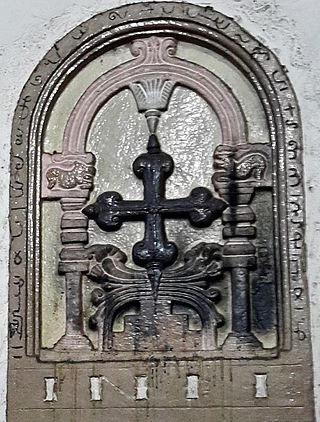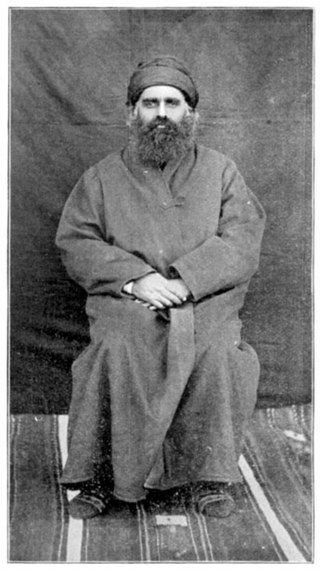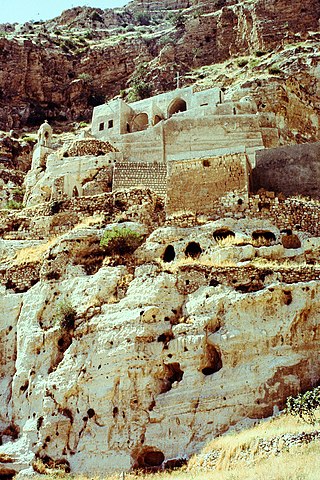Related Research Articles

The Assyrian Church of the East (ACOE), sometimes called the Church of the East and officially known as the Holy Apostolic Catholic Assyrian Church of the East, is an Eastern Christian church that follows the traditional Christology and ecclesiology of the historical Church of the East. It belongs to the eastern branch of Syriac Christianity, and employs the Divine Liturgy of Saints Addai and Mari belonging to the East Syriac Rite. Its main liturgical language is Classical Syriac, a dialect of Eastern Aramaic.
Qudshanis, is a small village in the Hakkâri District of Hakkâri Province, Turkey. The village is populated by Kurds of the Pinyanişî tribe and population was 30 in 2023.

The Chaldean Syrian Church of India is an Eastern Christian denomination, based in Thrissur, in India. It is organized as a metropolitan province of the Assyrian Church of the East, and represents traditional Christian communities of the East Syriac Rite along the Malabar Coast of India. It is headed by Mar Awgin Kuriakose.

Mar Shimun XX Paulos served as the 118th Catholicos-Patriarch of the Assyrian Church of the East.

Chaldean Catholic Eparchy of Seert was a diocese of the Chaldean Catholic Church, centered in Seert. It existed during the eighteenth, nineteenth and early-twentieth centuries. The diocese was ruined during the First World War.

Mar Shimun XVII Abraham served as the Catholicos-Patriarch of the Assyrian Church of the East from c. 1820 to 1861.

The Church of the East or the East Syriac Church, also called the Church of Seleucia-Ctesiphon, the Persian Church, the Assyrian Church, the Babylonian Church or the Nestorian Church, is one of three major branches of Eastern Nicene Christianity that arose from the Christological controversies in the 5th century and the 6th century, alongside that of Miaphysitism and the Chalcedonian Church.

The patriarch of the Church of the East is the patriarch, or leader and head bishop of the Church of the East. The position dates to the early centuries of Christianity within the Sassanid Empire, and the Church has been known by a variety of names, including the Church of the East, Nestorian Church, the Persian Church, the Sassanid Church, or East Syrian.

Metropolitanate of India was an East Syriac ecclesiastical province of the Church of the East, at least nominally, from the seventh to the sixteenth century. The Malabar region (Kerala) of India had long been home to a thriving Eastern Christian community, known as the Saint Thomas Christians. The community traces its origins to the evangelical activity of Thomas the Apostle in the 1st century. The Christian communities in India used the East Syriac Rite, the traditional liturgical rite of the Church of the East. They also adopted some aspects of Dyophysitism of Theodore of Mopsuestia, often inaccurately referred as Nestorianism, in accordance with theology of the Church of the East. It is unclear when the relation between Saint Thomas Christian and the Church of the East was established. Initially, they belonged to the metropolitan province of Fars, but were detached from that province in the 7th century, and again in the 8th, and given their own metropolitan bishop.

Mar Shimun XVIII Rubil served as the Catholicos-Patriarch of the Assyrian Church of the East from 1861 to 1903, succeeding his uncle Shimun XVII Abraham.
Shimun Yahballaha, also designated in some modern historiographical works as Yahballaha IV, or even Yahballaha V, was Patriarch of the pro-Catholic line of primates of the Church of the East, from c. 1572 to c. 1580. In primary sources, he is mentioned as patriarch Shimun by several inscriptions dated from 1572 to 1577, while his additional name Yahballaha is recorded in a later report, submitted to Rome (1581) by metropolitan Eliya. The same report describes recently deceased patriarch Yahballaha Shimun as an elderly hierarch, who was elected to the patriarchal see sometime after the death of Abdisho IV Maron, but did not seek confirmation from Rome, due to his advanced age.
Shimun X was Patriarch of the Shemʿon line of primates of the Church of the East, from c. 1600 to c. 1638. He is claimed both by the Chaldean Catholic Church and the Assyrian Church of the East. Upon accession to the patriarchal throne, he moved his seat from Urmia to Salmas, and also resided in Khananis near Qodshanis. He succeeded Patriarch Shimun IX Dinkha who was in full communion with the Catholic Church. Unlike his predecessor, who was officially recognized by Rome as the Patriarch of the Chaldeans, Shimun X was not formally recognized by the Catholic Church because his election was based on hereditary principle, reintroduced after the death of his predecessor. Hereditary succession was considered an unacceptable practice by the Rome. In 1616, contacts between patriarch Shimun X and the Catholic Church were initiated, upon arrival of Catholic missionaries to the region. Patriarch composed a profession of faith, that was sent to Rome for assessment. Upon examination, Shimun′s profession was found inadequate, and he was not received into communion with the Catholic Church. Similar attempt was made in 1619, but wit no final conclusion. Because of such complex situation, his legacy was viewed differently along denominational lines, and claimed by both sides. He is considered as pro-Catholic by the Chaldean Catholic Church, and also as non-Catholic by the Assyrian Church of the East.
Mar Shimun XVI Yohannan was Patriarch of the Shem'on line (Qodshanis) of the Church of the East, from 1780. In 1804, he became the sole Patriarch among traditionalist Christians of the East Syriac Rite, because the rival Patriarch Eliya XII (1778-1804) of the Eliya line died without successor. Shimun XVI remained patriarch until his death in 1820.

Mar Yohannan, also known as a monk Yoseph of Awgin, was Bishop of India, a metropolitan province of the Church of the East. In 1490, envoys of Saint Thomas Christians from the Malabar Coast in India traveled to Mesopotamia and arrived in Gazarta, bringing appeals to the hierarchy of the Church of the East, and asking for new bishops. Patriarch Shemon IV responded positively to their request and arranged the selection of two monks from the Awgin Monastery, both of them called Yoseph, appointing them as bishops, under new names: Mar Yohannan and Mar Thoma, and dispatching them to India. Mar Yohannan stayed in India, while Mar Thomas returned to Mesopotamia. In 1503, three new bishops were sent to India, by new Patriarch Eliya V: Mar Yahballaha, Mar Dinkha and Mar Yaqob. Upon arrival, they met with Mar Yohannan. Activities of Mar Yohannan and other bishops reaffirmed traditional ties between Christians of India and the Church of the East. By that time, local Christians of the Malabar Coast were also facing some additional challenges, caused by the establishment of Portuguese presence in India.

Several historical evidences shed light on a significant Malankara–Persian ecclesiastical relationship that spanned centuries. While an ecclesiastical relationship existed between the Saint Thomas Christians of India and the Church in Sassanid Empire in the earlier centuries, closer ecclesiastical ties developed as early as seventh century, when India became an ecclesiastical province of the Church of the East, albeit restricted to matters of purely ecclesiastical nature such as ordination of priests, and not involved in matters of temporal administration. This relationship endured until the Portuguese protectorate of Cochin of Malabar came to be in 16th century, and the Portuguese discovery of a sea route to India. The Christians who came under the two ancient yet distinct lineages of Malankara and Persia had one factor in common: their Saint Thomas heritage. The Church of the East shared communion with the Great Church until the Council of Ephesus in the 5th century, separating primarily over differences in Christology.

Eliya VI was Patriarch of the Church of the East from 1558 to 1591, with residence in Rabban Hormizd Monastery, near Alqosh, in modern Iraq. In older historiography, he was designated as Eliya VI, but later renumbered as Eliya "VII" by some authors, who believed that during the period from 1558 to 1591 there were two successive Eliya patriarchs. After the resolution of several chronological questions, he was designated again as Eliya VI, and that numeration is accepted in recent scholarly works.
Mar Elīyā V was the patriarch of the Church of the East from September 1502 until his death in 1504.

Eliya X was Patriarch of the Church of the East from 1700 to 1722, with residence in Rabban Hormizd Monastery, near Alqosh, in modern Iraq. During his tenure, traditional ties of the Patriarchate with the remaining Christian community of the East Syriac Rite in India were re-established, and in 1708 bishop Mar Gabriel was sent there by the Patriarch, succeeding upon arrival to the Malabar Coast to revive the local East Syriac Christian community.

Eliya XI was Patriarch of the Church of the East from 1722 to 1778, with his residence in Rabban Hormizd Monastery, near Alqosh, in modern Iraq. His father, the priest Hoshaba, was the brother of the previous patriarch Eliya X. Upon that patriarch's death, Eliya XI was elected to the patriarchal see, and enthroned on 25 December 1722.
References
- 1 2 3 4 5 6 7 Baum, Wilhelm; Dietmar W. Winkler (2003). The Church of the East: A Concise History. Routledge. p. 53. ISBN 0-415-29770-2 . Retrieved 2 March 2009.
- 1 2 Bremmer, Jan N. (2001). The Apocryphal Acts of St. Thomas. Peeters Publishing. p. 145. ISBN 90-429-1070-4.
- ↑ Symposium Syriacum 1972: Célébré Dans Les Jours 26-31 Octobre 1972 à L'Institut Pontifical Oriental de Rome : Rapports Et Communications. Pontificium Institutum Orientalium Studiorum. 1974.
- ↑ Piepkorn, Arthur Carl (1977). Profiles in Belief: The Religious Bodies of the United States and Canada . Harper and Row. ISBN 978-0-06-066580-7.
david of basra.
- ↑ Moffet, Samuel H. (1998). A History of Christianity in Asia. Orbis Books. p. 266. ISBN 1-57075-162-5.
- 1 2 3 4 Irvin, Dale T. (2001). History of the World Christian Movement. Continuum International. p. 203. ISBN 0-567-08866-9.
- ↑ Wilmshurst, David (2000). The Ecclesiastical Organisation of the Church of the East, 1318-1913. Peeters Publishers. p. 89. ISBN 90-429-0876-9.
- 1 2 3 Neill, Stephen (2004). A History of Christianity in India. Cambridge University Press. p. 41. ISBN 0-521-54885-3.
- ↑ Missick, Stephen Andrew (2000). "Mar Thoma: The Apostolic Foundation of the Assyrian Church and the Christians of St. Thomas in India" (PDF). Journal of Assyrian Academic Studies. XIV (2): 33–61. Retrieved 2 March 2009.
- 1 2 Baum, Wilhelm (2004). Shirin: Christian, Queen, Myth of Love. Gorgias Press. p. 9. ISBN 978-1-59333-282-2.[ permanent dead link ]
- ↑ Kreider, Alan (2001). The Origins of Christendom in the West. Continuum International. p. 130. ISBN 0-567-08776-X.
- ↑ Barrett, David B. (2001). World Christian Trends, AD 30 - AD 2200. William Carey Library. p. 114. ISBN 0-87808-608-0.